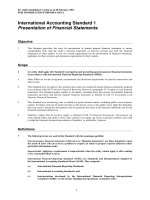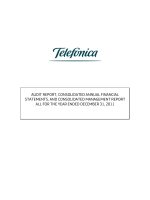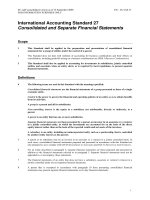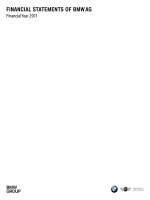Understanding financial statements
Bạn đang xem bản rút gọn của tài liệu. Xem và tải ngay bản đầy đủ của tài liệu tại đây (2.35 MB, 77 trang )
Understanding Financial
Statements
Sanjay Dhamija
Why Accounting
Informational requirement of a number of stakeholders in
the business
Internal Stakeholder
External Stakeholders
Owners
Management
Employees
Government/ Tax department
Investors
Banks/Lenders
Suppliers/Creditors
NGOs/ Industry associations
Researchers
Accounting is the tool for providing financial information to
various stakeholders
Financial Accounting Information
Predominately used by external stakeholders
though managers also use it for decision
making
To ensure that the accounting information is `true
& fair’
Generally Accepted Accounting Principles (GAAP)
Accounting Standards
Unification of Accounting Standards (IFRS)
Accounting principles are not `exact’
Some latitude with the management
GAAP
GAAP
Good accounting practices evolved by the profession
over a period of time
Most of these practices have been adopted explicitly
in the Accounting Standards
Accounting Standards
Mandatory accounting/ disclosure principles
prescribed by an authority
In India Accounting Standards are prescribed by the
Institute of Chartered Accountants of India
So far 32 accounting standards have been issued by
the ICAI
Please note
Financial Statement are prepared in accordance
with the applicable GAAP/ Accounting Standards
The format is prescribed by the Companies Act
1956
They are audited by the `external auditors’
The audit report is addressed to the shareholders
In case of listed companies – periodic disclosure
(quarterly basis) is required to be made.
Annual accounts are required to be presented to
the shareholders’ for approval within six months of
the close of the year
Basic Financial Statements
To answer the three basic questions
How much profit was generated by the business
over a particular period?
What are the assets and liabilities of the
business at the end of a particular period?
What were the sources and uses of cash over a
particular period?
Financial Statements
Profit & Loss Account
Balance Sheet
Cash Flow Statement
Income Statement
Profit and Loss Account of XYZ Ltd. for the Year ended March 31st 20XX
Income
Sales
Other Income
Expenditure
Material and Other Expenditure
Interest
Depreciation
Profit Before Tax
Provision for Tax
Profit After Tax
Prior period adjustments
Extra Ordinary Items
Profit available for appropriations
Appropriations
Dividend
Dividend Distribution Tax
General Reserve
Surplus carried to Balance Sheet
Schedule
No.
Previous Year
Current Year
xxx
xxx
xxx
xxx
xxx
xxx
xxx
xxx
xxx
xxx
xxx
xxx
xxx
xxx
Revenue Recognition
Revenue
Sales of Goods
Rendering of Services
Use by others of enterprise resources yielding
interest, royalties and dividends
Sales of Goods
Seller has transferred property in goods to the
buyer for a consideration
Transfer of significant risk and rewards of
ownership to the buyer
Revenue Recognition
Rendering of Services
Recognise revenue when services are
performed
Proportionate Completion Method
Performance consists of a series of acts
Revenue recognised proportionately by reference
to performance of each act
Completed Service Contract Method
Performance consists of a single act; or
Performance can’t be deemed to be completed
unless fully executed
Revenue Recognition
Interest
On a time proportion basis taking into account amount
outstanding and the interest rate
Royalties
On an accrual basis with the terms of the relevant
agreement
Dividend
When the right to receive payment is established
Impact of uncertainties
If there is uncertainty regarding the amount of the
consideration at the time of sale or rendering of services
Postpone revenue recognition till it is reasonably certain
If uncertainty arises subsequently
Make a separate provision to reflect uncertainty rather
than adjust the amount of revenue originally recorded
Depreciation (AS 6)
Most of the Fixed Assets have limited useful life
The cost of a Fixed Assets needs to appropriated on a
systematic basis over its useful life
This process of appropriation is called depreciation
Based upon the `Matching Principle’
Different Terms
Depreciation
Real Assets with limited useful life
Depletion
Natural resources
Amortization
Intangible assets
Determinants of Depreciation
Amount of depreciation depends upon
Cost of Acquisition
Expected Useful Life
Estimated Residual Value
Expected Useful Life
Period / Production Units
Physical Life
Extent of use
Legal / Contractual Requirements
Technological Changes – Obsolescence
Past experience
Determinants of Depreciation
Estimated Residual Value
Amount expected to be realized on disposal
If considered insignificant – taken as Nil
Otherwise based upon the past experience
Depreciable Value
Cost of Acquisition – Estimated Residual Vale
Depreciation
Cost of Acquisition – Residual Value
Useful Life
Depreciation Methods
Method of allocating the cost of assets over
its useful life
Straight Line Method (SLM)
Written Down Value Method (WDV)
Unit of Production Method
Sum of Digits Method
The Management is free to use any method
The method chosen must be applied
consistently from period to period
Straight Line Method
Depreciable amount is amortized equally over the useful
life of the asset
Depreciation = Cost – RV
Useful Life
Depreciation charge in each period remains same over
the useful life of the asset
Simple to operate / understand
Accelerated Methods
Written Down Value (WDV) Method
Higher depreciation in the earlier years
Depreciation is calculated by applying a
rate to the net book value in the beginning
of the year
Sum of years’ digit Method
Depreciation for 1st year = n/SYD
SYD = n(n+1)/2
Depreciation Rates - Schedule XIV of the
Companies Act
WDV
SLM
Building - Factory
Other
Temporary
10.00
5.00
100.00
3.34
1.63
100
Plant & Machinery- Single shift
Double Shift
Triple Shift
13.91
20.87
27.82
4.75
7.42
10.4
Electrical Fittings
13.91
4.75
Vehicles (Motor Carr, Motor cycles, scooters)
Buses & Lorries (other than used for hire)
25.89
30.00
9.50
11.31
Furniture & Fittings
18.10
6.33
Individual assets costing less than Rs.5000
100%
100%
Inventory
AS 2 `Valuation of Inventories’ issued by the ICAI in
June 1981
What is inventory
Assets
Held for sale in the ordinary course of
business
In the process of production for such sale
In the form of materials or supplies to be
consumed in the production process or in
the rendering of services
Importance
Profit = Sales - COGS
Cost of Goods Sold = (Opening Stock + Purchases –
Closing Stock)
Opening Stock + Purchases = Closing Stock + COGS
Closing Stock (inventories) appears in the Balance
Sheet as Current Assets
Inventories often constitute (except in case of a
Services Company) a significant portion of the total
assets of a company
Problem
How to apportion goods available for sale between
ending inventory and cost of good sold ?
Valuation of Inventory
Inventories should be valued at the lower of cost and net
realisable value
Valuation process
Ascertain cost
Ascertain net realisable value
Value at lower of cost and net realisable value
Cost of Inventories
Comprises of cost of purchase, costs of
conversion and other cost incurred to bring
inventories to their present location and
condition
Cost of Purchases
Includes purchase price, duties and taxes,
freight inwards and other expenses directly
attributable to the acquisition
Trade discounts, rebates, duty drawbacks etc
are deducted
Cost of Conversion
Cost directly related to the production
Systematic allocation of fixed and variable
production overheads
Costs not to be considered for valuation
Interest & borrowing costs
Abnormal wastages
Storage costs (unless necessary in the
production process before further production)
Administrative overheads
Selling & Distribution Overheads
Cost Formulas
For identifying the cost
Specific Identification
FIFO
LIFO
Weighted Average Method
AS 2 permits use of Specific Identification, FIFO and
Weighted Average Cost Method









